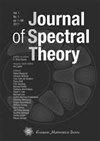海森堡型群上的量子演化和次拉普拉斯算子
IF 0.8
3区 数学
Q1 MATHEMATICS
引用次数: 11
摘要
本文分析了在海森堡型李群上薛定谔方程的一组解的时间平均能量密度的演化。我们使用一种半经典的方法来适应群体的分层结构,并描述与这个家族相关的半经典测量(也称为量子极限)。这允许我们通过子拉普拉斯算子生成的半群证明描述伪微分半经典算子量子演化的Egorov型定理。本文章由计算机程序翻译,如有差异,请以英文原文为准。
Quantum evolution and sub-Laplacian operators on groups of Heisenberg type
In this paper we analyze the evolution of the time averaged energy densities associated with a family of solutions to a Schrodinger equation on a Lie group of Heisenberg type. We use a semi-classical approach adapted to the stratified structure of the group and describe the semi-classical measures (also called quantum limits) that are associated with this family. This allows us to prove an Egorov's type Theorem describing the quantum evolution of a pseudodifferential semi-classical operator through the semi-group generated by a sub-Laplacian.
求助全文
通过发布文献求助,成功后即可免费获取论文全文。
去求助
来源期刊

Journal of Spectral Theory
MATHEMATICS, APPLIED-MATHEMATICS
CiteScore
2.00
自引率
0.00%
发文量
30
期刊介绍:
The Journal of Spectral Theory is devoted to the publication of research articles that focus on spectral theory and its many areas of application. Articles of all lengths including surveys of parts of the subject are very welcome.
The following list includes several aspects of spectral theory and also fields which feature substantial applications of (or to) spectral theory.
Schrödinger operators, scattering theory and resonances;
eigenvalues: perturbation theory, asymptotics and inequalities;
quantum graphs, graph Laplacians;
pseudo-differential operators and semi-classical analysis;
random matrix theory;
the Anderson model and other random media;
non-self-adjoint matrices and operators, including Toeplitz operators;
spectral geometry, including manifolds and automorphic forms;
linear and nonlinear differential operators, especially those arising in geometry and physics;
orthogonal polynomials;
inverse problems.
 求助内容:
求助内容: 应助结果提醒方式:
应助结果提醒方式:


